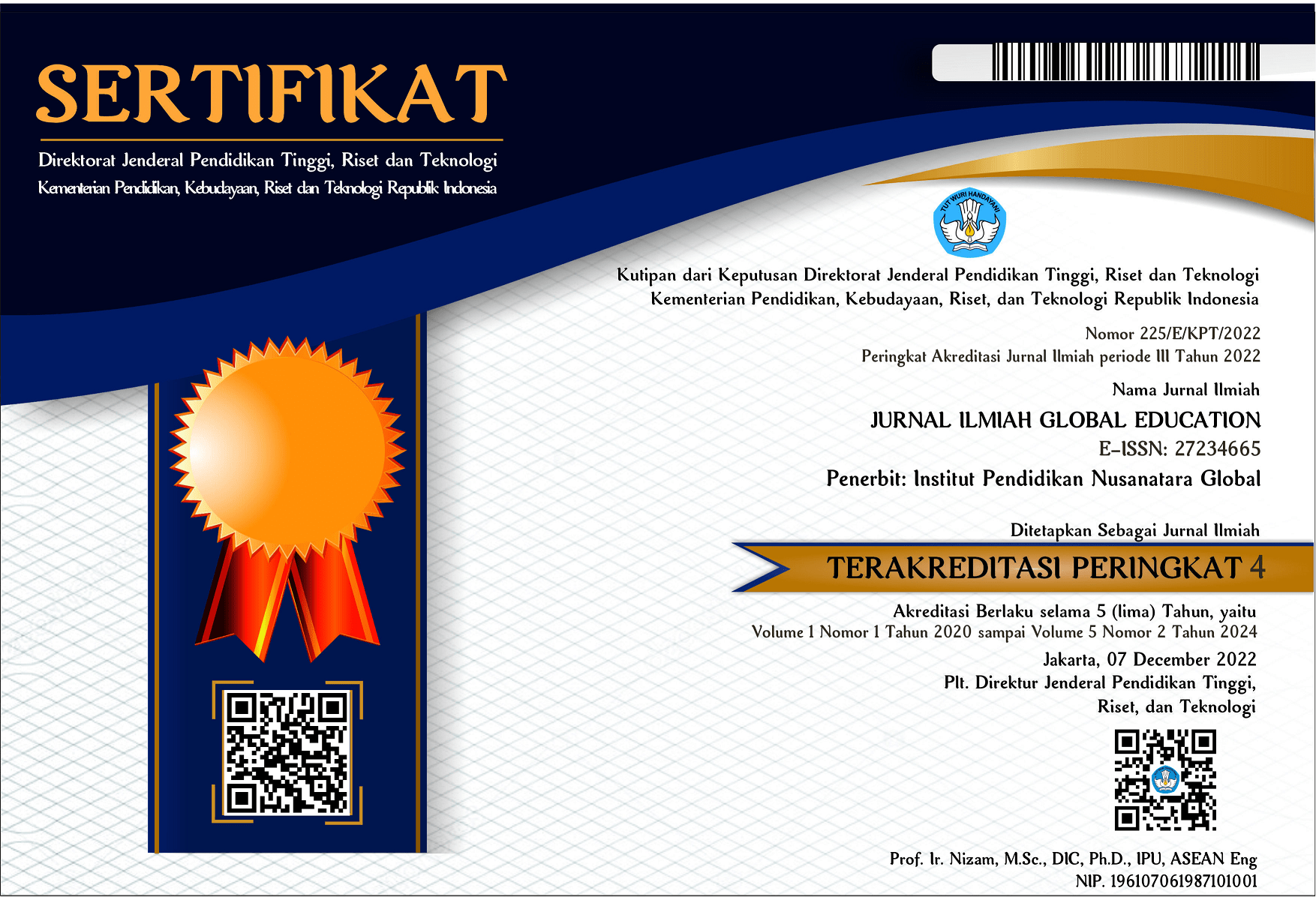TOURISM DEVELOPMENT WITH QUALITY TOURISM APPROACH IN ULOS HUTARAJA VILLAGE
DOI:
https://doi.org/10.55681/jige.v4i4.1288Keywords:
Quality Tourism, Kampung Ulos, Huta RajaAbstract
This study aims to know the development of the tourism quality in Ulos Hutaraja Village. This study used qualitative research methods. Overall, the quality of tourism in Kampung Ulos Hutaraja is strongly influenced by several factors. First, tangible factors include adequate infrastructure and physical facilities, such as accommodation, transportation, tourist attractions, restaurants and shops that meet quality standards. Second, is the responsiveness factor, which includes the ability of tourism managers to provide services that are responsive to the needs and expectations of tourists. Third, the assurance or guarantee factor involves security, comfort, and trust in the tourism experience. Fourth is the reliability factor, which emphasizes consistency, timeliness, and service continuity. Fifth, the participant factor highlights the participation of local communities in tourism development, which can provide a more authentic experience and protect the environment. Sixth is the accessibility factor, which relates to adequate transportation and infrastructure access. In addition, cultural authenticity is essential in maintaining and promoting local culture as the main attraction for tourists, maintaining cultural integrity and avoiding excessive commercialization. Finally, cohesiveness or harmony is an essential indicator of maintaining a balance between tourism, the environment and local communitiy welfare through natural preservation, cultural preservation, tourism impact research, sustainable policies, fair social and economic benefits, and collaboration with related parties. By paying attention to these factors, Kampung Ulos Hutaraja can build quality, sustainable and beneficial tourism for all parties involved.
Downloads
References
Atilgan, E., Akinci, S., & Aksoy, S. (2003). Mapping service quality in the tourism industry. Managing ServiceQuality: An International Journal, 13(5), 412-422.
Chao-qun, C. (2012). Reaches on the Rural Tourism Experience Authenticity Based on the Local Dwellers , the Rural Tourists and the Rural Tourism Operators. 52(Icime 2011). https://doi.org/10.7763/IPCSIT.2012.V52.65
Chen, X., Cheng, Z. feng, & Kim, G. B. (2020). Make it memorable: Tourism experience, fun, recommendation and revisit intentions of Chinese outbound tourists. Sustainability (Switzerland), 12(5), 1–24. https://doi.org/10.3390/su12051904
Costa, I., Joukes, V., Diniz, F., & Cantante, A. C. (2017). Cities and enhancement of their historic centre and heritage: Educational communities’ and visitors’ perspectives. Regional Science Inquiry, 9(1), 85–95. https://www.scopus.com/inward/record.uri?eid=2-s2.0-85026314057&partnerID=40&md5=f656a23939aa936fa3c0d67773532c00
Creswell, J. W. (2014). Research Qualitative, Quantitative, and Mixed Methods Approaches Design Fourth Edition. In Sage Publications.
Dwijayati, A. K. , S. D. (2016). Identification of Potential and Development Srategy of Ecotourism In Mangrove Forest Conservation Area of Pasar Banggi Village Rembang Regency. In DIPONEGORO JOURNAL OF MAQUARES (Vol. 5, Issue 4). http://ejournal- s1.undip.ac.id/index.php/maquares .
Ferretti, V., Bottero, M., & Mondini, G. (2014). Decision making and cultural heritage: An application of the Multi-Attribute Value Theory for the reuse of historical buildings. Journal of Cultural Heritage, 15(6), 644–655. https://doi.org/10.1016/j.culher.2013.12.007
Gundana. (2023). Menelusuri Konsep 3A dalam Pariwisata: Atraksi, Aksesibilitas, dan Amenitas yang Menjaga Pengelolaan Destinasi Wisata Berjalan Baik.
Handayani, S., Wahyudin, N., & Khairiyansyah, K. (2019). Fasilitas, Aksesibilitas Dan Daya Tarik Wisata Terhadap Kepuasan Wisatawan. Jurnal Ilmiah Manajemen Dan Bisnis, 20(2), 123–133. https://doi.org/10.30596/jimb.v20i2.3228
Hubner, I. B., Irene, N., Sitorus, B., & Pramono, R. (2020). The Effect of Nation Branding “ Thoughtful Indonesia ” upon the Decision Process of International Tourists to Visit Indonesia in New Normal Era / amid the Covid-19 Pandemic. 07(10), 3362–3373.
Juliana, J., Pramezwary, A., Yuliantoro, N., Purba, J. T., Pramono, R., & Purwanto, A. (2021). Perceptions , Attitudes , and Interests of Halal Tourism : An Empirical Study in Indonesia. 8(7), 265–273. https://doi.org/10.13106/jafeb.2021.vol8.no7.0265
Juliana, J, Sihombing, S., & Antonio, F. (2022). Memorable Tourism Experience Bibliometric Analysis: A Systematic Review. Jurnal Mantik, 6(2), 2302–2313. https://ejournal.iocscience.org/index.php/mantik/article/view/2751
Juliana, J., Sihombing, S. O., & Antonio, F. (2022). The Research Trend of Memorable Rural Tourism Experience : Systematic Literature Review and Bibliometric Analysis. 19716–19731.
Juliana, J., & Sitorus, N. B. (2022). Kelengkapan Produk Wisata di Pulau Siladen Sebagai Destinasi Wisata Bahari. Khasanah Ilmu - Jurnal Pariwisata Dan Budaya, 13(1), 26–37. https://doi.org/10.31294/khi.v13i1.11688
Juliana, Sihombing, S. O., & Antonio, F. (2022). What Drives Memorable Rural Tourism Experience: Evidence from Indonesian Travelers. International Journal of Sustainable Development and Planning, 17(8), 2401–2411. https://doi.org/10.18280/ijsdp.170807
Kaharuddin, Napitulu, Junika, Juliana, Pramono, Rudy, Saragih, E. L. L. (2021). Determinants of Tourist Attraction of the Heritage Tourism. Journal of Environmental Management and Tourism, VII(4).
Lemy, Diena M, Pramono, Rudy, Juliana, J. (2022). Acceleration of Environmental Sustainability in Tourism Village. International Journal of Sustainable Development and Planning, 17(4), 1273–1283. https://doi.org/https://doi.org/10.18280/ijsdp.170425
Mahmud, Y., Krisnanda, R., Fitriatul ’ulya, A., & Puspitasari, R. (2022). Kajian Aksesibilitas, Amenitas, Atraksi Dan Pelayanan Tambahan Terhadap Minat Kunjungan Pada Cafe Sawah Desa Wisata Pujon Kidul (Vol. 2, Issue 2). https://jurnal.unmer.ac.id/index.php/
McIntosh, R. W. , G. C. R. and R. J. R. B. (1995). Pleasure Travel Motivation. In: Tourism: Principles, Practices, Philosophies, 7th Edition, 167-190.
Nugraha, K. S. W., Suryaningsih, I. B., & Cahyanti, I. D. (2021). Destination quality, experience involvement and memorable tourism experience: Is it relevant for rural tourism? Management and Marketing, 16(1), 69–85. https://doi.org/10.2478/mmcks-2021-0005
Park, J., & Jeong, E. (2019). Service quality in tourism: A systematic literature review and keyword network analysis. Sustainability (Switzerland), 11(13). https://doi.org/10.3390/su11133665
Rahman, M. (2017). Destination selection for education tourism: Service quality, destination image and perceived spirituality embedded model. Journal of Islamic Marketing, 8(3), 373–392. https://doi.org/10.1108/JIMA-10-2015-0080
Satriana, E. D., & Faridah, H. D. (2018). Halal Tourism: Development, Chance and Challenge. Journal of Halal Product and Research, 1(2), 32. https://doi.org/10.20473/jhpr.vol.1-issue.2.32-43
Alvin Hung-Chih Yu, D. M. G. C. (2006). SERVICE QUALITY IN TOURISM: A CASE STUDY OF THE 2001 STUDY TOUR OF TAIWAN.
Sriwi, O. A. , & H. I. (2019). Identifikasi Potensi Wisata Desa Selong Belanak Kabupaten Lombok Tengah. 8(2), 79. Http://Stp-Mataram.E-Journal.Id/Jhi .
Sthapit, E. and Jime´nez-Barreto, J. (2018). Exploring tourists’ memorable hospitality experiences: an Airbnb perspective”, TourismManagementPerspectives, Vol. 28, pp. 83-92.
Su, L., Swanson, S.R. and Chen, X. (2016). The effects of perceived service quality on repurchase intentions and subjective well-being of Chinese tourists: the mediating role of relationship quality”, Tourism Management, Vol. 52, pp. 82-95.
Su, M. M., Wall, G., & Xu, K. (2016a). Heritage tourism and livelihood sustainability of a resettled rural community: Mount Sanqingshan World Heritage Site, China. Journal of Sustainable Tourism, 24(5), 735–757. https://doi.org/10.1080/09669582.2015.1085868
Su, M. M., Wall, G., & Xu, K. (2016b). Heritage tourism and livelihood sustainability of a resettled rural community: Mount Sanqingshan World Heritage Site, China. Journal of Sustainable Tourism, 24(5), 735–757. https://doi.org/10.1080/09669582.2015.1085868
Sugiyono. (2020). Metode Penelitian Pariwisata : Kuantitatif, Kualitatif, Kombinasi, R&D, Alfabeta, Bandung.
Suryana, M. , R. S. , P. S. , P. U. , & B. N. (2020). Identifikasi Potensi Pengembangan Pariwisata Halal di Desa Wisata Lebak Muncang Kabupaten Bandung. In Jurnal Ilmiah Pariwisata (Vol. 25, Issue 1).
Thompson, M. (2020). Farmers’ markets and tourism: Identifying tensions that arise from balancing dual roles as community events and tourist attractions. Journal of Hospitality and Tourism Management, 45(September 2019), 1–9. https://doi.org/10.1016/j.jhtm.2020.06.016
Toana, R. D. A. (2022). The Role of Tourists ’ Emotional Experiences in Recommending Tourist Attractions : A Case Study of Tourist Satisfaction on Onrust Island. JURNAL ABIWARA, 3(2), 177–185.
Utama, I. G. B. R. and T. C. P. (2021). The Implementation of the MOA Method in Ecotourism of Buyan-Tamblingan, Bali, Indonesia (March 23, 2021). I. Gusti Bagus Rai Utama, Christimulia Purnama Trimurti. The Implementation of the MOA Method in Ecotourism of Buyan-Tamblingan, Bali, Indonesia. International Journal of Modern Agriculture, 10(01), 957 - 970. , Available at SSRN: https://ssrn.com/abstract=3811948.
Utama, I Gusti Bagus Rai, Laba I Nengah, Junaedi I Wayan Ruspendi, Krismawintari Ni Putu Dyah, Turker, Sidhi Bayu, Juliana, J. (2021). Exploring Key Indicators of Community Involvement in Ecotourism Management. Journal of Environmental Management and Tourism, VII(4). https://doi.org/https://doi.org/10.14505//jemt.12.3(51).20
Vengesayi, S. (2003). A conceptual model of tourism destination competitiveness and attractiveness. https://www.researchgate.net/publication/242414026
Vengesayi, S., Mavondo, F. T., & Reisinger, Y. (2009). Tourism destination attractiveness: Attractions, facilities, and people as predictors. Tourism Analysis, 14(5), 621–636. https://doi.org/10.3727/108354209X12597959359211
Vieira, A. (2005). Delivering quality service: All for one? Journal of Quality Assurance in Hospitality and Tourism, 6(1), 25–42. https://doi.org/10.1300/J162v06n01_03
Vuković, P., & Ružičić, M. M. (2017). Potentials of Upper Danube Region in the Republic of Serbia for Sustainable Tourism Development. Green Economy in the Western Balkans. https://doi.org/10.1108/978-1-78714-499-620171008.
Weidenfeld, A. (2010). Iconicity and ‘flagshipness’ of tourist attractions”, Annals of Tourism Research, Vol. 37 No. 3, pp. 851-854.
Yang, Y. (2018). Understanding tourist attraction cooperation: An application of network analysis to the case of Shanghai, China. Journal of Destination Marketing and Management, 8(September 2017), 396–411. https://doi.org/10.1016/j.jdmm.2017.08.003
Zhou, X., Wong, J. W. C., & Wang, S. (2022). Memorable Tourism Experiences in Red Tourism: The Case of Jiangxi, China. Frontiers in Psychology, 13. https://doi.org/10.3389/fpsyg.2022.899144
Downloads
Published
How to Cite
Issue
Section
License
Copyright (c) 2023 JURNAL ILMIAH GLOBAL EDUCATION

This work is licensed under a Creative Commons Attribution-ShareAlike 4.0 International License.













